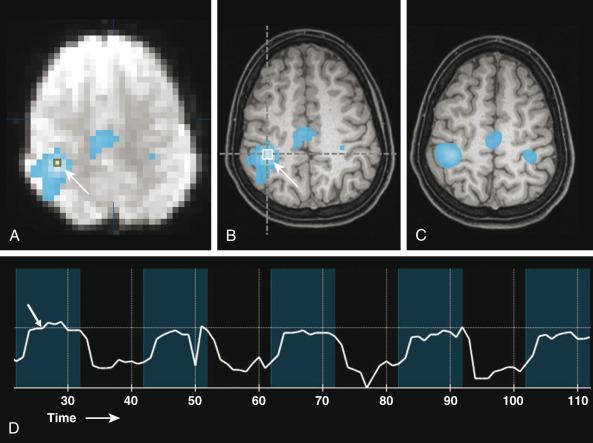Physical Address
304 North Cardinal St.
Dorchester Center, MA 02124
Functional magnetic resonance imaging (fMRI) is based on the blood oxygen level–dependent (BOLD) contrast effect and neuronal activity–cerebrovascular flow coupling. Oxygenated blood (oxyhemoglobin) is diamagnetic, producing little susceptibility-related dephasing on magnetic resonance (MR) signal. Deoxyhemoglobin is paramagnetic and elicits a more prominent effect on local field homogeneity and phase coherence, resulting in signal loss. Changes in the relative concentrations of oxyhemoglobin and deoxyhemoglobin in the vascular bed therefore result in changes in regional MR signal. The increase in cerebral blood flow that accompanies neuronal activity results in a relative increase in oxyhemoglobin concentration and a resultant localized increase in MR signal. The actual physiology underlying the BOLD response is complex and is the subject of ongoing research. Many anatomic and physiologic changes occur during brain development that have the potential to alter the BOLD response in children compared with adults. Despite these physiologic differences, the basic BOLD response in children is generally similar to that in adults, albeit with some task-related differences. Neonates and infants may exhibit significantly different BOLD responses than do older children and adults, complicating interpretation in this age group.
The requirements for fMRI performance include an MRI scanner with gradient hardware capable of performing fMRI useable sequences, stimulation/presentation hardware and software linked to the scanner to allow for synchronization of stimuli and MR imaging, hardware and software for documenting patient responses, and postprocessing software for producing activation maps. The small BOLD effect changes in MR signal typically are detected by echo-planar imaging (EPI) T2*-sensitive gradient recalled echo techniques. Because of increased signal to noise and sensitivity for BOLD contrast effects, 3T scanners are preferred for fMRI studies.
Performance of useful clinical fMRI examinations in children requires specialized preparation and resources. The patient is assessed for underlying neurologic deficits, developmental level, and ability to complete the fMRI paradigms. Explanation of the MR procedure and fMRI paradigms to the patient and parents in a calm, child-centered environment is critical. Practicing the fMRI paradigms is important to maximize performance and to adapt the tasks for the patient's clinical and developmental level. Video presentations and mock scanners are highly useful in preparing children for the fMRI environment. Patient comfort should be maximized.
Patient motion can influence fMRI performance in children. Despite some ability to retrospectively correct for head motion, gross head movement typically results in unusable fMRI data. Head coil bite bars, inflatable head cushions, and forehead and chin straps may be used but can be difficult to implement. Head motion is more pronounced in younger children and in boys. Older children and girls have a higher rate of successfully completed examinations. With care and adequate preparation, most children presenting for clinical fMRI studies can complete fMRI examinations with multiple administered paradigms. The routine application of real-time fMRI processing can reduce the number of inadequate studies.
For task-based fMRI examinations, repeated samplings of the brain (one brain volume scan during each repetition time period) while the subject alternates between active cognitive and control tasks typically is performed (the fMRI “paradigm”). Typical fMRI paradigms require 3 to 7 minutes of imaging time for acquisition of 100 or more image volumes during three to five cycles of alternating behavior. Although many approaches are possible, clinical fMRI is most commonly performed in a “blocked-periodic” design in which blocks of task and control (baseline) conditions are administered sequentially. The fMRI paradigm that is used ideally will result in activation of brain regions involved with the sensory, motor, or cognitive task presented, without activation in other regions. The proper choice of control and task conditions is important to allow this distinction and must be carefully matched to elicit detectable BOLD signal and isolate the function of interest. For successful performance of fMRI examinations in children, utilization of age and developmentally appropriate paradigms is mandatory.
Imaging processing is required for fMRI and should involve the interpreting radiologist. After acquisition of images during the fMRI paradigm, the images typically are processed to diminish EPI artifacts, correct for susceptibility-related distortions, limit effects from patient movement during the paradigm, align and transform the T2* EPI images to a higher resolution anatomic dataset, and statistically analyze the images for BOLD signal changes between the task conditions on a voxel-by-voxel basis (the statistical map) ( Fig. 27.1 ). Increasingly, streamlined, clinically oriented options are being offered on most clinical MR systems or by a growing number of third-party vendors. The most common statistical tests used for clinical fMRI are the general linear model and the cross-correlation method. Determination of the optimum statistical threshold for use in individual clinical patients is a complex issue. Evaluating fMRI studies at multiple different thresholds is important to maximize clinical effectiveness.

Although many indications for pediatric fMRI are undergoing active research evaluation, the most common clinical use of fMRI in children is for presurgical assessment of language and memory function for patients with intractable epilepsy and evaluation of potentially eloquent cortex in patients with brain lesions (e.g., tumors and cavernous malformations).
Some fundamental concepts must be kept in mind when performing and interpreting fMRI studies in clinical patients. For example, fMRI activation regions are not functionally specific, and lack of activation in a brain region does not indicate lack of critical brain function. The fMRI procedure is an indirect evaluation of neuronal function and relies on statistical mapping techniques that are not clinically standardized. The BOLD effect can be directly altered by pathologic states with changes in cerebrovascular autoregulation and neurovascular coupling, including vascular steno-occlusion, tumors with high vascularity, and arteriovenous malformations. Artifacts from regions of susceptibility effect (e.g., skull base, sinuses, hemorrhage, and prior surgery) may limit fMRI sensitivity. Sedation also can alter the BOLD response significantly.
Become a Clinical Tree membership for Full access and enjoy Unlimited articles
If you are a member. Log in here